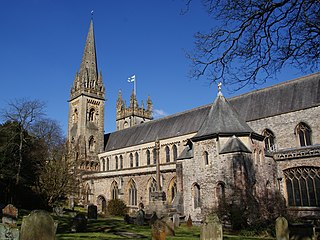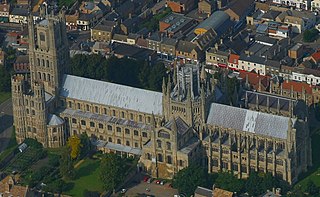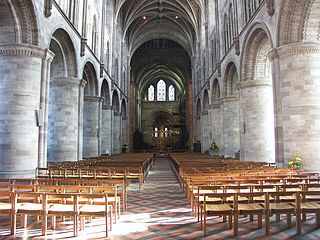Related Research Articles

Llandaff Cathedral is an Anglican cathedral and parish church in Llandaff, Cardiff, Wales. It is the seat of the Bishop of Llandaff, head of the Church in Wales Diocese of Llandaff. It is dedicated to Saint Peter and Saint Paul, and three Welsh saints: Dubricius, Teilo and Oudoceus. It is one of two cathedrals in Cardiff, the other being the Roman Catholic Cardiff Metropolitan Cathedral in the city centre.
Ralph d'Escures was a medieval abbot of Séez, bishop of Rochester, and then archbishop of Canterbury. He studied at the school at the Abbey of Bec. In 1079 he entered the abbey of St Martin at Séez and became abbot there in 1091. He was a friend of both Archbishop Anselm of Canterbury and Bishop Gundulf of Rochester, whose see, or bishopric, he took over on Gundulf's death.

Browne Willis was an antiquary, author, numismatist and politician who sat in the House of Commons from 1705 to 1708.

The Bishop of Llandaff is the ordinary of the Church in Wales Diocese of Llandaff.

Hervey le Breton was a Breton cleric who became Bishop of Bangor in Wales and later Bishop of Ely in England. Appointed to Bangor by King William II of England, when the Normans were advancing into Wales, Hervey was unable to remain in his diocese when the Welsh began to drive the Normans back from their recent conquests. Hervey's behaviour towards the Welsh seems to have contributed to his expulsion from his see. Although the new king, Henry I wished to translate Hervey to the see of Lisieux in Normandy, it was unsuccessful.
Jocelin of Wells was a medieval Bishop of Bath. He was the brother of Hugh de Wells, who became Bishop of Lincoln. Jocelin became a canon of Wells Cathedral before 1200, and was elected bishop in 1206. During King John of England's dispute with Pope Innocent III, Jocelin at first remained with the king, but after the excommunication of John in late 1209, Jocelin went into exile. He returned to England in 1213, and was mentioned in Magna Carta in 1215.
Walter of Kirkham was a medieval English official who held the positions of Keeper of the Wardrobe, Dean of York, and Bishop of Durham. He was elected bishop over Aymer de Valence, 2nd Earl of Pembroke, the brother of King Henry III. As bishop, he was instrumental in the founding of Balliol College in the University of Oxford.
Hugh of Beaulieu was a medieval English Bishop of Carlisle.
Ranulf of Wareham was a medieval Bishop of Chichester.
Reynelm was a medieval Bishop of Hereford.
Richard de Capella or Richard of the Chapel was a medieval Bishop of Hereford.

Robert de Bethune was a medieval bishop of Hereford. From a knightly family, he became a teacher before becoming a canon by 1115. He was elected prior of Llanthony Priory in the middle 1120s, and was named bishop by King Henry I of England in 1130. As bishop, he was often appointed a judge by the papacy, and was known for the care he took of his diocese.

Hugh de Mapenor was a medieval Bishop of Hereford. Although educated and given the title of magister, or "master", the details of his schooling are unknown. Mapenor was a clerk for Giles de Braose, his predecessor as bishop. Later, Mapenor served as Dean of Hereford before being elected as bishop against the wishes of King John of England. During his short episcopate, he supported John's son and successor King Henry III of England, and was active in his diocese, as a number of surviving documents show. He also served as a diplomat for the king.
William de Blois was a medieval Bishop of Lincoln. He first served in the household of Hugh du Puiset, the Bishop of Durham, then later served the household of Hugh of Avalon, Bishop of Lincoln. After Hugh's death and a two-year vacancy in the see, or bishopric, Blois was elected to succeed Hugh in 1203. Little is known about his episcopate, although 86 of his documents survive from that time period. He died in 1206 and was buried in his cathedral.
Richard de Belmeis was a medieval cleric, administrator and politician. His career culminated in election as Bishop of London in 1152. He was one of the founders of Lilleshall Abbey in Shropshire.

The Priory Church of St Mary, Abergavenny is a parish church in the centre of Abergavenny in Monmouthshire, Wales.

Sir David Mathew, was a Welsh Knight. He was Lord of Llandaff and Seneschal of Llandaff Cathedral, and one of the ten Great Barons of Glamorgan, a Marcher Lord. It was said he was one of the most distinguished men of his age and a zealous supporter of the Yorkist cause. After saving the life of King Edward IV at the Battle of Towton in 1461, he was appointed Grand Standard Bearer of England and King Edward IV granted the use of 'Towton' on his arms.
David FitzGerald was a medieval Bishop of St David's in Wales.
The Archdeacon of St Davids is a senior cleric in the Church in Wales' Diocese of St Davids. The archdeacon is the senior priest with responsibility over the area of the archdeaconry of St Davids, one of three archdeaconries in the diocese. The Archdeaconry of St Davids comprises the four rural deaneries of Daugleddau, Dewisland/Fishguard, Pembroke and Roose.
This article is about the particular significance of the year 1720 to Wales and its people.
References
- 1 2 Pryde, E. B. Greenway, D. E. (1996). Handbook of British Chronology. Cambridge University Press. p. 293. ISBN 978-0-5215-6350-5.
{{cite book}}: CS1 maint: multiple names: authors list (link) - ↑ Pearson, M. J. (2003). "The Welsh cathedrals 1066-1300', in Fasti Ecclesiae Anglicanae 1066-1300: Volume 9, the Welsh Cathedrals". British History Online. Retrieved 5 April 2016.
- 1 2 Willis, Browne (1719). A Survey of the Cathedral-Church of Landaff. R. Gosling. pp. 48–49.
- ↑ Clark, George Thomas (1862). The Land of Morgan: Being a Contribution Towards the History of the Lordship of Glamorgan. Whiting. p. 87.
- ↑ Willis, Browne (1719). A Survey of the Cathedral-Church of Landaff. R. Gosling. p. 119.
Henry de Abergavenny.